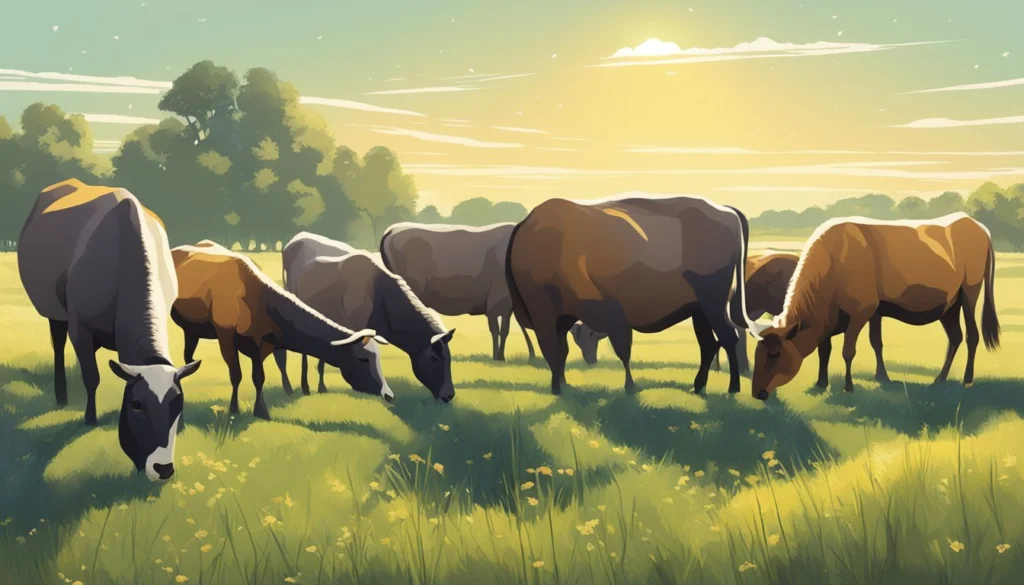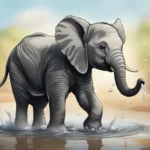Grass-eating animals, also known as herbivores, play a vital role in ecosystems by maintaining the balance between vegetation and animal life. These creatures have evolved specialized diets and digestive systems that allow them to thrive on a diet composed almost entirely of grass. Let’s explore 10 fascinating animals that rely on grass as their primary food source.
1. Cows
Cows are perhaps the most well-known grass-eaters and are commonly raised as livestock for their meat and milk. As ruminants, they have a specialized stomach with four compartments, which allows them to efficiently digest tough plant fibers found in grass. Cows spend a significant portion of their day grazing and chewing cud, a process that helps break down grass into digestible nutrients.
Their dependence on grass not only sustains them but also plays a critical role in agricultural systems, where cows convert inedible plant material into valuable products like milk and meat for human consumption.
Key Facts:
- Ruminant with a four-chambered stomach
- Spends up to 8 hours a day grazing
- Converts grass into essential nutrients
2. Horses
Horses are non-ruminant herbivores but still have an efficient digestive system designed to process grass. Their large, flat teeth are perfect for grinding down fibrous plant material, and their long digestive tract allows them to absorb nutrients from grass effectively. Unlike cows, horses do not chew cud, but they are grazing animals that feed throughout the day.
Horses often graze on lush pastures, and their ability to survive on grass makes them ideal companions for humans, from agricultural work to recreational riding.
Key Facts:
- Non-ruminant herbivore
- Continuously grazes throughout the day
- Efficiently digests fibrous plant material
3. Sheep
Sheep are another ruminant herbivore that relies heavily on grass for sustenance. They have a four-part stomach similar to cows, which allows them to break down the cellulose in grass through a process of fermentation. Sheep are well-adapted to grazing in a variety of landscapes, from lush meadows to rocky hillsides, and their diet is primarily composed of grass and other plant materials.
Domesticated sheep are an important part of agriculture, providing wool, meat, and milk, all of which are produced from a diet largely based on grass.
Key Facts:
- Ruminant with a complex digestive system
- Efficient at converting grass into energy
- Key source of wool, meat, and milk
4. Zebras
Zebras, native to the grasslands and savannas of Africa, are well-suited to a grass-based diet. Like horses, zebras are non-ruminant herbivores but have adapted to grazing on tough, coarse grasses. Their large, grinding teeth are specialized for breaking down fibrous plant material, which is crucial for survival in their dry, arid habitats where other vegetation might be scarce.
Zebras spend most of their day grazing and are able to thrive on grasses that are less nutritious than what many other herbivores eat, giving them a competitive edge in the wild.
Key Facts:
- Native to African grasslands
- Non-ruminant but well-adapted to tough grasses
- Can survive on low-nutrition grass
5. Bison
Bison, often referred to as buffalo in North America, are large, powerful herbivores that primarily eat grass. As ruminants, they have a digestive system that allows them to extract nutrients from the tough grasses found on the prairies and grasslands where they roam. Bison graze for long periods and use their large, strong heads to push through snow or brush to reach grass in winter.
Historically, bison were a crucial part of the Great Plains ecosystem, maintaining grassland health by grazing and trampling, which promoted new growth.
Key Facts:
- Ruminant herbivore found in grasslands
- Can graze in extreme conditions
- Crucial for maintaining prairie ecosystems
6. Elephants
Elephants, the largest land animals on Earth, are herbivores that eat a variety of plants, but grass makes up a significant part of their diet, especially during certain seasons. Elephants can consume hundreds of pounds of grass, leaves, and other plant material each day to sustain their massive bodies. Their trunks are adapted for grabbing large clumps of grass, and their strong molars help grind down the plant material.
Despite their size, elephants are selective feeders and often move through large areas, grazing and shaping the landscape by uprooting plants and trees.
Key Facts:
- Eats large quantities of grass and plant material
- Uses its trunk to pull up grass and other vegetation
- Plays a key role in shaping ecosystems
7. Giraffes
While giraffes are more famous for eating the leaves of tall trees, particularly acacia, they are also known to graze on grass when their preferred food sources are scarce. Giraffes will bend their long necks down to the ground to nibble on grasses, particularly during dry seasons when other vegetation is less available. Their flexible diets make them adaptable in the wild, allowing them to survive in a variety of habitats.
Though not primarily grass-eaters, giraffes demonstrate how herbivores can diversify their diets to meet their nutritional needs.
Key Facts:
- Primarily eats leaves but will graze on grass when needed
- Highly adaptable diet
- Can survive in different ecosystems
8. Rabbits
Rabbits are small herbivores with a diet that consists largely of grass, hay, and other plant materials. Unlike ruminants, rabbits have a unique digestive process called hindgut fermentation, where they re-digest their food to extract as many nutrients as possible. Rabbits produce two types of droppings, one of which they consume to reabsorb nutrients from partially digested grass.
This efficient system allows rabbits to thrive in environments where grass is plentiful, making them prolific grazers in many ecosystems.
Key Facts:
- Uses hindgut fermentation to digest grass
- Produces and re-eats specialized droppings
- Thrives in grass-rich environments
9. Guinea Pigs
Guinea pigs, though small, are dedicated grazers. In the wild, they feed on a variety of grasses and plants, and their domesticated counterparts require hay and grass as a staple part of their diet. Guinea pigs have continually growing teeth, which are kept in check by the constant chewing of fibrous grasses. Without access to grass or hay, their teeth can become overgrown, leading to health problems.
Their reliance on grass helps keep their digestive system healthy and functioning, as the fiber is essential for proper gut movement.
Key Facts:
- Primarily eats grass and hay
- Requires constant chewing to maintain dental health
- Needs high-fiber diets for healthy digestion
10. Kangaroos
Kangaroos, native to Australia, are grass-eating marsupials that graze across the country’s grasslands and savannas. Like many herbivores, they rely on fibrous grasses as their main food source. Kangaroos have chambered stomachs, similar to ruminants, which allow them to break down the tough fibers in grass through fermentation.
Kangaroos play an important ecological role in their native habitats, helping to manage grassland vegetation and serving as prey for larger carnivores.
Key Facts:
- Native to Australian grasslands
- Has a chambered stomach for digesting grass
- Plays a vital role in maintaining grassland ecosystems
Conclusion
Grass-eating animals come in all shapes and sizes, from the massive elephants and bison to the small and agile rabbits and guinea pigs. Each of these animals has evolved unique adaptations that allow them to efficiently digest tough, fibrous grass and thrive in their respective environments. These herbivores play a critical role in maintaining the balance of ecosystems by grazing on vegetation, shaping landscapes, and supporting food chains.
FAQ
What animals eat only grass?
Animals like cows, sheep, bison, and zebras primarily eat grass, relying on it as their main source of food.
Do elephants eat only grass?
No, elephants eat a variety of plants, including leaves, bark, and fruits, but grass makes up a significant portion of their diet during certain seasons.
How do cows digest grass?
Cows have a four-chambered stomach that allows them to break down the cellulose in grass through a process of fermentation and cud chewing.
Why do rabbits eat grass?
Rabbits rely on grass for its high fiber content, which is essential for their digestion and dental health.
Can kangaroos survive on grass alone?
Yes, kangaroos primarily eat grass and have developed specialized digestive systems to break down tough plant fibers.
Do all herbivores eat grass?
Not all herbivores eat grass exclusively. While some animals primarily eat grass, others, like giraffes and elephants, have more varied diets that include leaves and other plant materials.


